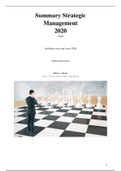Resume
Strategic Management - 2020/2021 - Comprehensive Summary with HOC note's
- Cours
- Strategic Management
- Établissement
- Vrije Universiteit Brussel (VUB)
This summary was based on previously existing summaries & all slides. The structure was fully updated and extra/new slide info was added. ALL important information mentioned in the HOC is written down in grey (2020/20201). ALL titles are structured so that during the exam you can look them up. ...
[Montrer plus]



